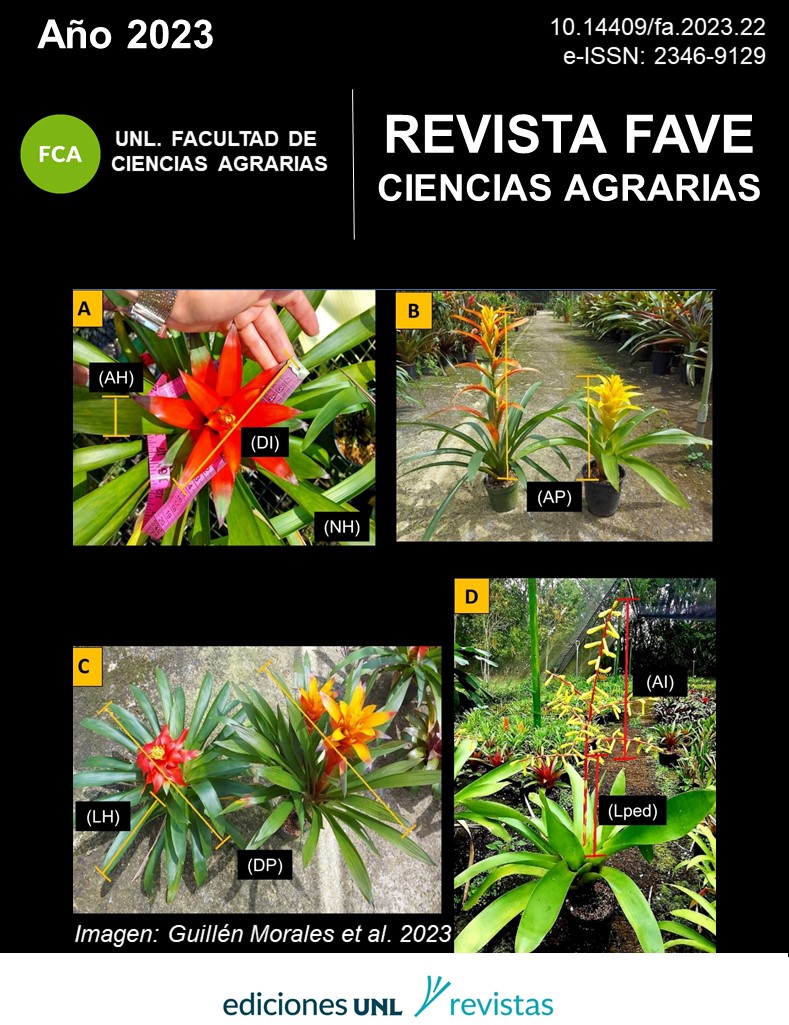Occurrence of Bipolaris cookei on sorghum in central-western Entre Ríos, Argentina
DOI:
https://doi.org/10.14409/fa.2023.22.e0014Keywords:
Sorghum, enfermedad, hongo, conidios con esporulación secundariaAbstract
In the province of Entre Ríos, Argentina, sorghum is grown for grain and forage, and also contributes to maintaining soil structural stability in production systems. In summer 2018, in two commercial hybrids of grain sorghum planted at the Paraná Agricultural Experimental Station of INTA (Oro Verde, Entre Ríos), dark brown, elliptical to oval, regular to somewhat irregular leaf spots, sometimes with diffuse margins, measuring approximately 3 x 5 mm, were observed in the middle and lower strata of the plants. Also, in summer 2019, on two pre-commercial hybrids and one commercial hybrid, in addition to the symptoms mentioned above, specks and purple spots with irregular and diffuse margins and delimited by the veins were detected on the youngest leaves, giving the appearance of a foliar "splash". The objectives of this work were to identify and characterize the causal organism of a foliar disease present in grain sorghum hybrids from central-western Entre Ríos. The symptoms observed in field samples and those produced in pathogenicity tests, the morphological characteristics of the colonies, as well as those of the conidia developed in vivo and in vitro, coincided with the descriptions made for Bipolaris cookei, the causal organism of the "target leaf spot" of sorghum. The information obtained contributes to the knowledge of this pathosystem in the sorghum producing region of Entre Ríos.
References
Acciaresi, H. & Mónaco, C. (1999). First report of Bipolaris sorghicola on Johnsongrass in Argentina. Plant Disease, 83, 965. doi.org/10.1094/PDIS.1999.83.10.965C
Ahmed, K.M. & Ravinder Reddy, CH. (1993). A pictoral guide to the identification of seedborne fungi of sorghum, pearl millet, finger millet, chickpea, pigeonpea, and groundnut. International Crops Research Institute for the Semi-Arid Tropics, Patancheru, Andhra Pradesh, India. Information Bulletin N° 34. 200 p. http://oar.icrisat.org/5236/
Bolsa de Cereales de Buenos Aires (2022). Panorama Agrícola Semanal. 18 de agosto de 2022. https://www.bolsadecereales.com/download/pass/documento1/939
Cúndom, M.A., Cabrera, M.G. & Gutiérrez, S.A. (2013). Bipolaris sorghicola un patógeno emergente en cultivos de sorgo del NE de Argentina. Summa Phytopathologica, 39(4), 295-296. doi.org/10.1590/S0100-54052013000400014
Da Silva Ferreira, A., Casela, C.R. & De Almeida Pinto, N.F.J. (2007). Manejo de doenças na cultura do sorgo. Embrapa Milho e Sorgo. Circular Técnica 89. 20 p. https://www.embrapa.br/busca-de-publicacoes/-/publicacao/486484/manejo-de-doencas-na-cultura-do-sorgo
Dalmacio, S.C. (1986). Target leaf spot. In: Frederiksen, R.A. (Ed.). Compendium of Sorghum diseases. APS Press, St. Paul, MN. p. 16-17.
Echemendía, M. (2005). Registro de enfermedades fungosas en Sorghum halepense (L.) Pers. Revista de Protección Vegetal, 20(1), 32-38.
Espíndola, C.M., Wuthrich, A.F., Deambrosi, A.M. & Giorda, L.M. (2017). INTA AER Las Toscas y el sorgo. Investigación en campo de productor. Generación de conocimientos para producción ganadera. 15 p. https://inta.gob.ar/sites/default/files/inta_aer_las_toscas_y_el_sorgo-_web.pdf
Farr, D.F. & Rossman, A.Y. (2022). Fungal Databases, U.S. National Fungus Collections, ARS, USDA. https://nt.ars-grin.gov/fungaldatabases/
French, E.R. & Hebert, T.T. (1980). Métodos de investigación fitopatológica. IICA, San José, Costa Rica, 289 p.
Giorda, L.M. (1997). Enfermedades. En: Giorda, L.M. (Ed.). Sorgo granífero. INTA Centro Regional Córdoba, EEA Manfredi, Córdoba, pp. 40-46.
Giorda, L.M. (2002). Sorghum Diseases in Argentina. In: Leslie, J.F. (Ed.). Sorghum and Millet Diseases. Iowa State Press, Ames, Iowa, pp. 389-392.
Index Fungorum (2022). Bipolaris cookei (Sacc.) Shoemaker. http://www.indexfungorum.org/names/NamesRecord.asp?RecordID=293675
Katewa, R., Mathur, K. & Bunker, R.N. (2006). Assessment of losses in Sorghum due to target leaf spot (Bipolaris sorghicola) at varying disease severity levels. Indian Phytopathology, 59(2), 237-239. http://eprints.icrisat.ac.in/5267/
Manamgoda, D.S., Rossman, A.Y., Castlebury, L.A., Crous, P.W., Madrid, H., Chukeatirote, E. & Hyde, K.D. (2014). The genus Bipolaris. Studies in Mycology, 79(1), 221-288. doi.org/10.1016/j.simyco.2014.10.002
MICAM (2000). Microscope Image Capture and Measurement. Version 3.0.2. http://science4all.nl/?Microscopy_and_Photography
Peng, C., Ge, T.T., He, X.L., Huang, Y.H., Zu, Z.L., Zhang, D.Y., Shao, H.B. & Guo, S.W. (2016). Process of Bipolaris sorghicola invasion of host cells. Genetics and Molecular Research, 15(1), gmr.15016781. https://doi.org/10.4238/gmr.15016781
Petrović, T., Arsenijević, M. & Lević, J. (1998). The occurrence of Bipolaris sorghicola on Johnsongrass in Yugoslavia. Zaštita bilja, 49(1), 57-70. https://www.researchgate.net/publication/318199777_Occurrence_of_Bipolaris_sorghicola_on_Johnsongrass_in_Yugoslavia
Piontelli Laforet, E. (2015). Especies oportunistas de importancia clínica de los géneros Bipolaris Shoemaker y Curvularia Boedijn: su caracterización bajo los nuevos criterios taxonómicos. Boletín Micológico, 30(2), 40-63. doi.org/10.22370/bolmicol.2015.30.2.348
SIBER (2021). Informe Producción de Sorgo - Campaña 2021/22. Bolsa de Cereales de Entre Ríos. https://www.bolsacer.org.ar/Fuentes/siberd.php?Id=1396
Silva, D.D., Casela, C.R., Ferreira, A.S., Silva, V.A., Martins, Z.C., Borges, M.H.D., Castro, H.A. & Guimarães, F.B. (2006). Primeiro relato de Bipolaris sorghicola, agente etiológico da “mancha alvo” em sorgo, no Brasil. In: Congresso Nacional de Milho e Sorgo, 26: trabalhos apresentados. Sete Lagoas, MG, Brasil. https://www.alice.cnptia.embrapa.br/alice/handle/doc/490155
SINAVIMO (2022). Sistema Nacional de Vigilancia y Monitoreo de Plagas. https://www.sinavimo.gob.ar/
Sivanesan, A. (1987). Graminicolous species of Bipolaris, Curvularia, Drechslera, Exserohilum and their teleomorphs. Mycological Papers, 158, 1-261.
Tarr, S.A.J. (1962). Target leaf spot. Foliage Diseases 1. Diseases of Sorghum, Sudan Grass and Broom Corn. CAB. Kew, Surrey, pp. 118-119.
Vanderlip, R.L. (1993). How a Sorghum Plant Develops, Kansas State University, Agricultural Experiment Station and Cooperative Extension Service. https://bookstore.ksre.ksu.edu/pubs/s3.pdf
Winder, R.S. & Van Dyke, C.G. (1989). Field testing of two Bipolaris species as mycoherbicides for Johnsongrass (Sorghum halepense). Proc. VII. Int. Symp. Biol. Contr. Weeds, March 1988, Rome, Italy. Delfosse, E.S. (Ed.). Ist. Sper. Patol. Veg. (MAF), pp. 565-570. http://bugwoodcloud.org/ibiocontrol/proceedings/pdf/7_565-570.pdf
Yi, J.-H., Kim, J.-W. & Lee, D.-H. (2001). Identification of Bipolaris, Drechslera, and Exserohilum isolated from gramineous hosts in Korea. The Korean Journal of Mycology, 29(2), 100-115. https://www.koreascience.or.kr/article/JAKO200104637436478.do
Published
How to Cite
Issue
Section
License
Copyright (c) 2023 FAVE Sección Ciencias Agrarias

This work is licensed under a Creative Commons Attribution-NonCommercial-ShareAlike 4.0 International License.

















